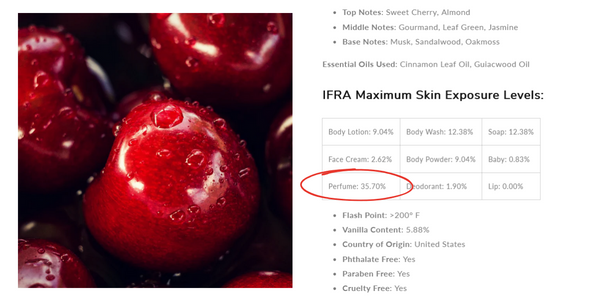Making your own perfume is easier than you might think! You only need two ingredients: a skin-safe perfume fragrance oil and some Perfume Base. To make perfume, you simply combine these ingredients and pour them into a fine mist perfume spray bottle. It’s really that easy!
When making perfume, there are a few things you’ll want to keep in mind. First, not all fragrance oils are skin-safe, meaning they aren’t all meant for products that come in contact with your skin. And second, you will need to check the IFRA certificate to determine how much fragrance you can use.
Follow this easy tutorial and you’ll learn everything you need to know to make perfume with confidence!
Watch a quick video of this project!
Step 1: Choosing a Fragrance Oil
There are tons of amazing perfume fragrance oils to choose from. The hardest part is deciding which one to use for your project! NorthWood Distributing carries a wide selection of designer-inspired perfume fragrances to choose from. You can try these in a Perfume Fragrance Sample Pack or pick out a few individual samples of your favorites. Here are some great suggestions for getting started:
Step 2: Check the IFRA Limit
Now that you have your fragrance picked out, it’s time to check how much you can use in your recipe. To do so, you will need to look at the IFRA certificate. These are available as PDF downloads for all our fragrances at the bottom of the Fragrance Description & Notes section. You can also find perfume in the quick-reference tables on our product pages.

Perfume is in found in Category 4 on IFRA certificates. For this project, we’re using our Lost Cherry fragrance oil. This has an IFRA limit of 35.70% for perfume, which means we could use a maximum of 35.70% fragrance oil by weight in our perfume recipe.
Learn more about IFRA limits in our blog.
Step 3: Determine Fragrance Load
Now that you know how much fragrance you can safely use, it’s time to decide how strong you want your perfume to smell. Most perfume will smell great at a concentration of just 5-10% fragrance oil. You can start with a smaller amount and work your way up to find your ideal scent.
In any case, you need to stay at or below the IFRA limit. For example, if your fragrance has an IFRA limit of 4% for perfume, don’t exceed that amount.
You also don’t want to exceed the amount that your base can hold. Our Perfume Base holds a maximum of 50% fragrance by weight. Even if your fragrance oil can be used at up to 75% according to the IFRA, you wouldn’t want to use more than 50% because the base would not be able to handle it.
Of course, a 50% fragrance load will usually smell overpoweringly strong, and you’d want to avoid doing this anyway. It’s always best to start with a small amount and work up to your desired scent level.
Note: If you are trying to make a specific type of perfume product, keep in mind that there are industry standards for the amount of scent used. For example, Eau de Parfum should contain 15-20% fragrance, while Eau de Toilette should contain between 5-15% fragrance. Read our blog on the different types of perfume if you are trying to make a specific product.
Step 4: Gather Supplies
To make perfume, you will need a few simple supplies and ingredients:
- Perfume fragrance oil
- Perfume base
- Perfume bottles
- Nitrile gloves
- 16 oz funnel pitcher
- Wire whisk
- Pipettes (recommended)
- Digital scale (recommended)
We aren’t providing specific measurements because the amount depends on your desired fragrance load and the number of bottles you want to make. For reference, a 16 oz bottle of Perfume Base will make around 10-12 bottles of perfume when using a 5-10% fragrance load.
Be sure to jot down your measurements so it’s easier to make your perfume blend in the next step.
Example Recipe: If I want to use a 10% fragrance load, I will need 5 ml of fragrance and 45 ml of base per 50 ml perfume bottle. If I wanted to make 10 bottles, I would need a total of 50 ml (1.7 oz) fragrance oil and 450 ml (15.2 oz) perfume base.
Step 5: Measure & Mix Ingredients
The fun part is here! You’re now ready to start making your perfume. Follow these easy steps:
- Wear gloves when working with fragrance oils. You may wish to cover your workspace to prevent spills.
- Place your funnel pitcher on the digital scale and tare it to zero.
- Weigh out the desired amount of perfume base and fragrance oil in the funnel pitcher. For small batches, we recommend using a pipette for measuring out the fragrance neatly.
- Stir the fragrance and base together with a whisk.
- Carefully pour 50 ml of perfume into each bottle, then attach the lids.
Step 6: Labeling Your Perfume
If you plan on selling your homemade perfumes, be sure to familiarize yourself with the FDA cosmetic labeling requirements. You can find the ingredients for our perfume base on its product label.
Fragrance oil can simply be listed as “Fragrance” on your perfume labels. Because ingredients should be listed by weight in descending order, we recommend placing Fragrance as the third ingredient on your labels (after SDA-40B and Distilled Water). If you use any additional ingredients, be sure to include these as well.
Did you make this project? We’d love to see how your perfume turned out! Tag us in your photos or use #MadeWithNorthWood on social media.
NorthWood is not responsible for the products you make with our supplies, ingredients, or informational resources. You are responsible for testing your end product for safety and compatibility.

